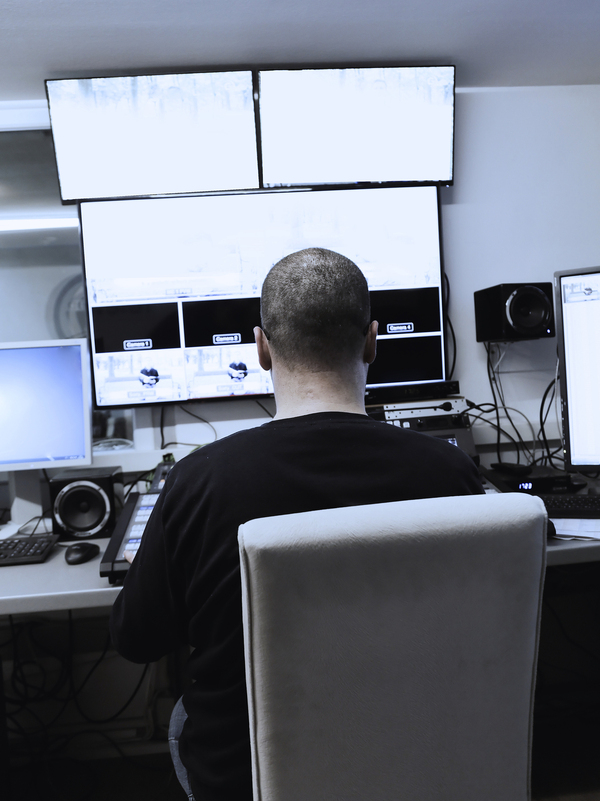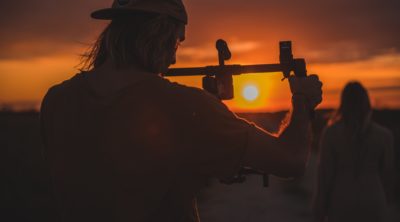< Back to all posts
To Switch or Not to Switch
Using multiple cameras during a video shoot is an easy way to boost intrigue in your corporate videos. With more than one camera on a shoot, there are more angles and a greater variety of shots to choose from.
A multiple camera shoot can be done with or without a switcher, and there are pros and cons to both options. We talked to one of our production managers, Valerie Nolan, about how a shoot like this operates and the advantages and drawbacks of shooting with and without a switcher.
First, let’s make sure we understand what a switcher is and why it is sometimes used on multiple camera shoots. A switcher, or a video mixer, connects the images that the cameras record and sends them out edited together into a completed program. The camera angles are viewed on a screen and the switcher manager, also called the technical director, is able to switch between the different cameras during the shoot. Basically, it edits all of your footage together during the shoot.
A typical scenario of a multiple camera shoot with a switcher would be a corporate livestream with three cameras. Executives and board members would sit in a conference room, give a quarterly presentation, and respond to questions from calls. The first camera would be focused on one speaker, like the CEO. The second camera would be focused on another speaker or executive member. The third camera would be a wide shot of everyone taking part in this presentation. It is a necessity that a switcher is present in this situation, or there would be no alternating shots.
Advantages of using a switcher:
- A switcher allows for a livestream option.
- There is usually a quick turnaround for a final product when a switcher is used.
- A switcher makes the production easier for the client because the crew does a lot of the editing in time during filming.
- “If a client has very limited editing time before presenting a final a product, the switcher allows them to shoot and edit simultaneously,” Nolan said. “Like the live presentation that your audience wants to access the next day on their laptops.”
Disadvantages of using a switcher:
- Alternating between cameras could cause the switcher manager to miss a crucial shot.
- A switcher adds to the cost of the shoot by increasing the equipment and personnel needed.
- If you have additional time, you will want more control of what selections are made in post without a switcher.
- “You need more equipment and more people to operate all of it,” Nolan said.
One typical scenario of a multiple camera shoot without a switcher would be a shoot where a crew uses three cameras for a two-person interview. The first camera would be aimed at one person and the second camera would be focused on the second person. The third camera would record both people at a wider shot. If there is no need for the interview to be viewed by your audience immediately, then it is best to skip the switcher and do your editing after the interview is done. The feeds from each camera are recorded separately (often referred to as ISO recording for “isolated) and then given to an editor to edit in after the shoot. You will capture multiple possible options for each portion of the final video. In order to add variety to a standard shoot -even a talking head video – it is useful to have a variety of shots to edit between (the close-up, the wide shot, and the side shot).

“Multiple camera shoots are more interesting in post,” Nolan said. “There is a greater variety of shots and there is no need to move a single camera back and forth to capture all presenters.”
Advantages of not using a switcher:
- All of the cameras capture the entire interview, presentation, or performance so there is no concern about missing a critical shot.
- This also allows the post-production to be done in a controlled manner with time to make decisions about the best angle or reading of a line, as well as the ability to add b-roll, graphics, or other features to the final video.
- “This process makes shooting easier and cheaper by limiting the gear and personnel needed on site,” Nolan said.
Disadvantages of not using a switcher:
- You may spend more money on the edit time than you would spend on a switcher and TD.
- Not having a switcher takes much more time in post to edit the footage together.
- “You lose the immediacy of being able to post your footage immediately,” Nolan said.
Whether you decide to use a switcher or not during your next production, multiple camera shoots are made simpler for all clients thanks to Crews Control.
“With Crews Control, you make one phone call and you get everyone you need. You get a cohesive team with one point of contact,” Nolan said.
If you’re interested in a multiple camera shoot, click here for a free quote.







Great piece! Another option would be to switch it live and also record (Iso) every camera or graphic source in case you need to fix sometime in post. It doesn’t add much expense and is a great backup plan. Add the iso records and a great director/td who knows multi-camera television and streaming and you add value to your executive or corporate communications town halls or shareholder meetings.